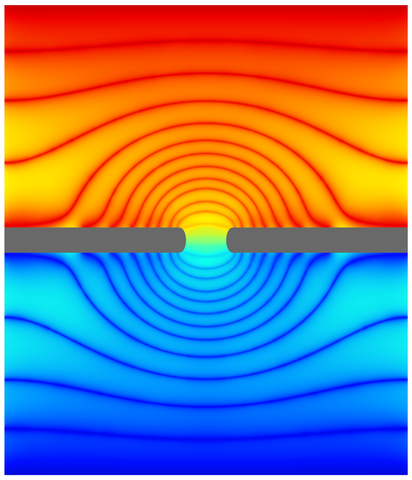Summary
The transport of particles through a region of space acquires an imprint of local information that enables sensing, such as detecting the presence of a biomolecule or a nucleotide in a sequence of DNA. In solid or condensed phases, electronic, vibronic, and ionic transport probes materials, interfaces, and active sensing regions. Accurate simulation of transport is key to quantifying information content (e.g., what types of biomolecules or processes can be detected). We are developing state-of-the-art algorithms and methods, as well as associated theoretical frameworks, for the simulation of transport in all these settings to support our programs in molecular biophysics and contribute to other research areas.
Description

We have recently developed a finite-size scaling approach and special simulation cell aspect ratio—the golden aspect ratio—to enable accurate incorporation of access resistant and bulk diffusion in ionic transport, see the figure. This enables quantitative, and efficient, prediction of ion transport properties in biological channels and synthetic nanopores. This resulted in the first ever calculation of access resistance in all-atom molecular dynamics simulations and resolved a long-standing discrepancy between experiment and computation regarding the radius dependence of conductance through graphene nanopores.
We have also developed a conceptual framework—the extended reservoir approach—that enables rigorous incorporation of particle and energy reservoirs for electronic, thermal, and energy transport. This framework permits efficient statistical averaging of the conductance (e.g., in aqueous sensing of biomolecules), as well as time-dependent coupling of structural and electronic degrees of freedom. Our work in this area also paved the way for a very efficient (exponentially more efficient than existing techniques) method for the simulation quantum many-body transport. We have worked with collaborators to integrate the extended reservoir approach within tensor network and matrix product state techniques.
Work with Us
Please contact Michael Zwolak at mpz [at] nist.gov (mpz[at]nist[dot]gov) to inquire about postdoctoral and collaborative opportunities.
Postdoctoral opportunities are available through a National Research Council (NRC) Fellowship, a 2-year program with application deadlines of February 1 and August 1 each year.
Additional information about the specific opportunities and the program are below:

